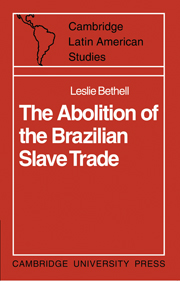Book contents
- Frontmatter
- Contents
- Preface
- Maps
- Abbreviations
- 1 First steps towards abolition, 1807–1822
- 2 Independence and abolition, 1822–1826
- 3 Brazil and the slave trade, 1827–1839
- 4 Treaty negotiations, 1830–1839
- 5 The British navy and the mixed commissions, 1830–1839
- 6 The extension of Britain's powers, 1839
- 7 Britain and the slave trade, 1839–1845
- 8 Slave trade, slavery and sugar duties, 1839–1844
- 9 Lord Aberdeen's Act of 1845
- 10 The aftermath of the Aberdeen Act
- 11 Changing attitudes and plans of action, 1845–1850
- 12 Crisis and final abolition, 1850–1851
- 13 The aftermath of abolition
- Appendix: Estimates of slaves imported into Brazil, 1831–1855
- Bibliography
- Index
3 - Brazil and the slave trade, 1827–1839
Published online by Cambridge University Press: 04 August 2010
- Frontmatter
- Contents
- Preface
- Maps
- Abbreviations
- 1 First steps towards abolition, 1807–1822
- 2 Independence and abolition, 1822–1826
- 3 Brazil and the slave trade, 1827–1839
- 4 Treaty negotiations, 1830–1839
- 5 The British navy and the mixed commissions, 1830–1839
- 6 The extension of Britain's powers, 1839
- 7 Britain and the slave trade, 1839–1845
- 8 Slave trade, slavery and sugar duties, 1839–1844
- 9 Lord Aberdeen's Act of 1845
- 10 The aftermath of the Aberdeen Act
- 11 Changing attitudes and plans of action, 1845–1850
- 12 Crisis and final abolition, 1850–1851
- 13 The aftermath of abolition
- Appendix: Estimates of slaves imported into Brazil, 1831–1855
- Bibliography
- Index
Summary
On 26 November 1826, a few days after the negotiations for an Anglo-Brazilian abolition treaty had been brought to a successful conclusion, Robert Gordon, the British minister in Rio de Janeiro, warned George Canning, the British Foreign Secretary, that the treaty was bound to be ‘in the highest degree unpopular’ in Brazil; it had been, he later admitted, ‘ceded at our request in opposition to the views and wishes of the whole Empire’. It was, however, six months before the Brazilian Chamber of Deputies was given an opportunity to voice the strongly anti-abolitionist opinions which the vast majority of influential white Brazilians undoubtedly held. In May 1827 the Chamber reassembled after a recess lasting almost twelve months and on 22 May the new Brazilian Foreign Minister, Marquês de Queluz (João Severiano Maciel da Costa)—himself the author of an abolitionist tract, Memoria sobre a necessidade de abolir a introducção dos escravos africanos no Brazil (published in Coimbra in 1821), in which he had argued that the trade would nevertheless be necessary for some little time to come—presented a report on the recent treaty negotiations with Britain in which he maintained that the Brazilian government had been forced to sign the treaty of 23 November 1826 entirely against their will. On 16 June 1827, the treaty was put in the hands of the Chamber's Comissão de Diplomacia which narrowly, by three votes to two, agreed to accept it.
- Type
- Chapter
- Information
- The Abolition of the Brazilian Slave TradeBritain, Brazil and the Slave Trade Question, pp. 62 - 87Publisher: Cambridge University PressPrint publication year: 1970

